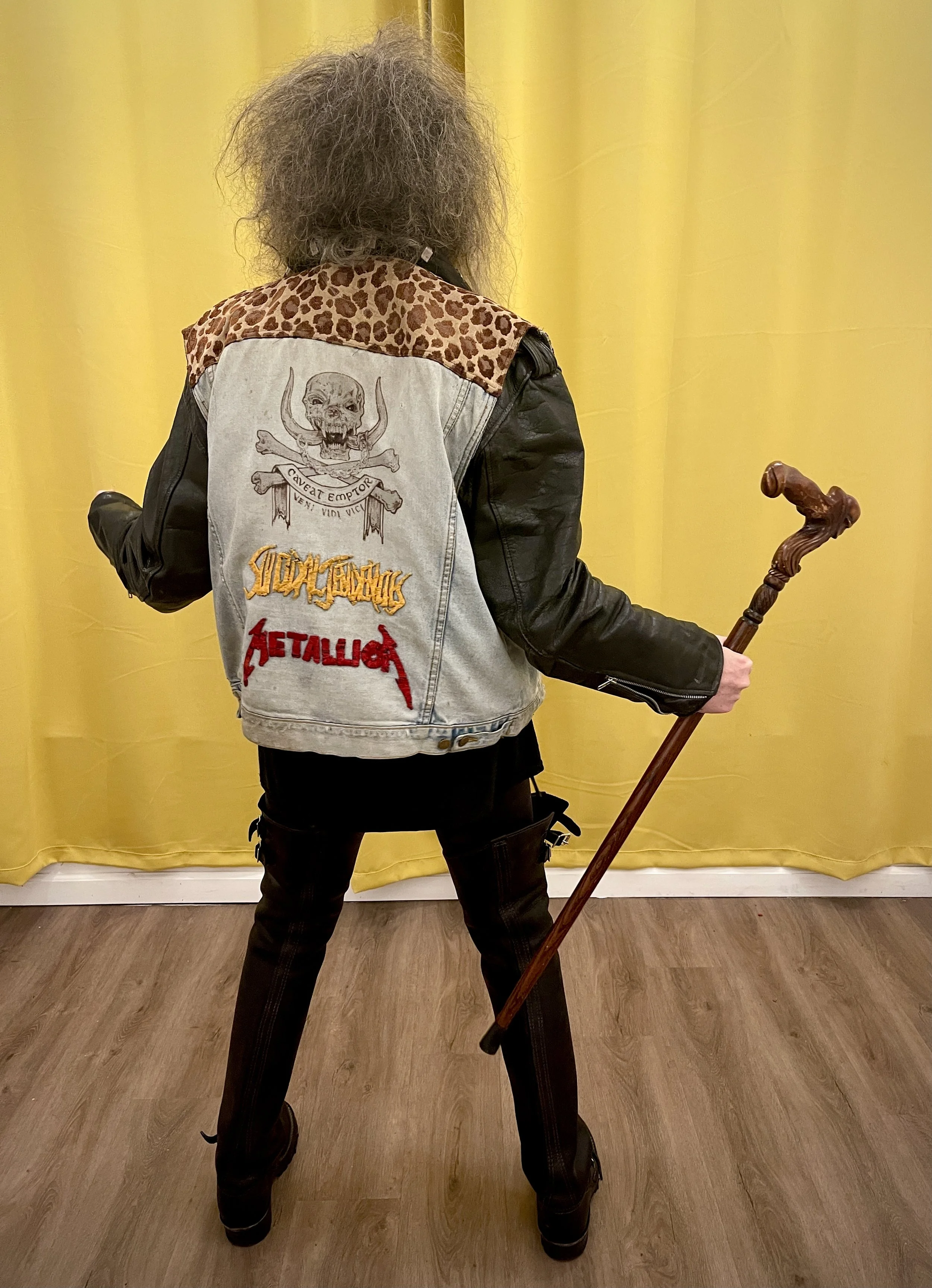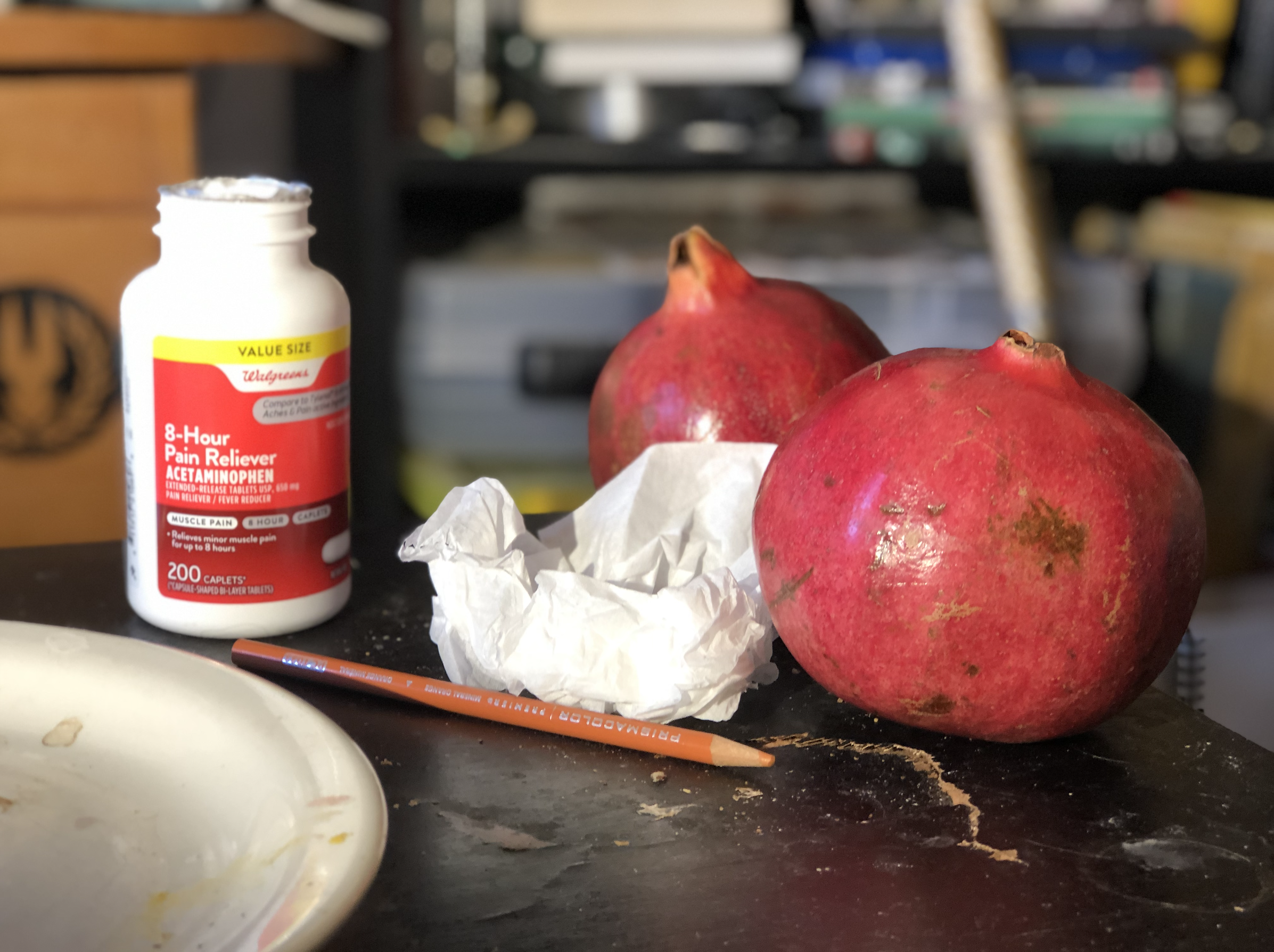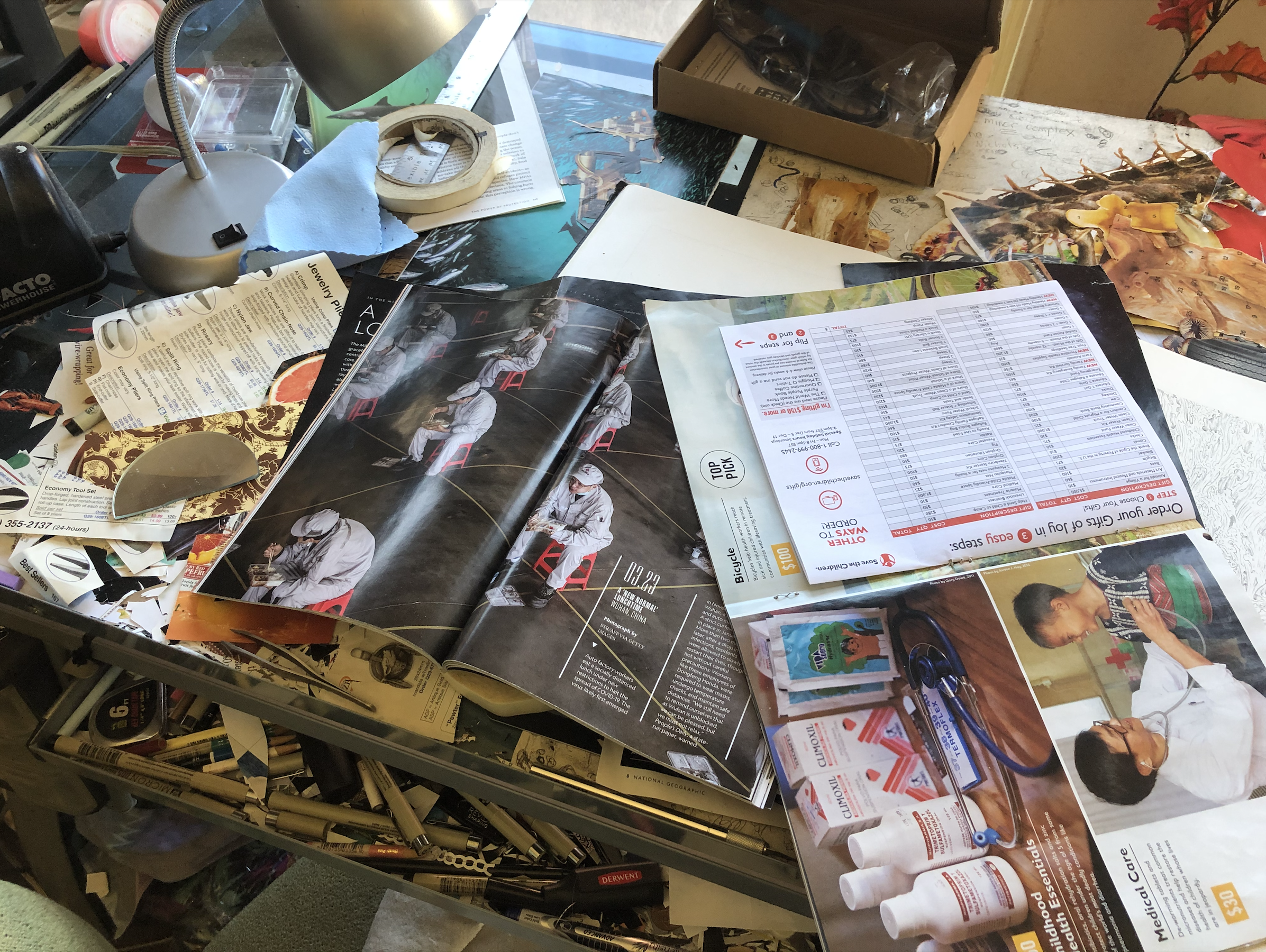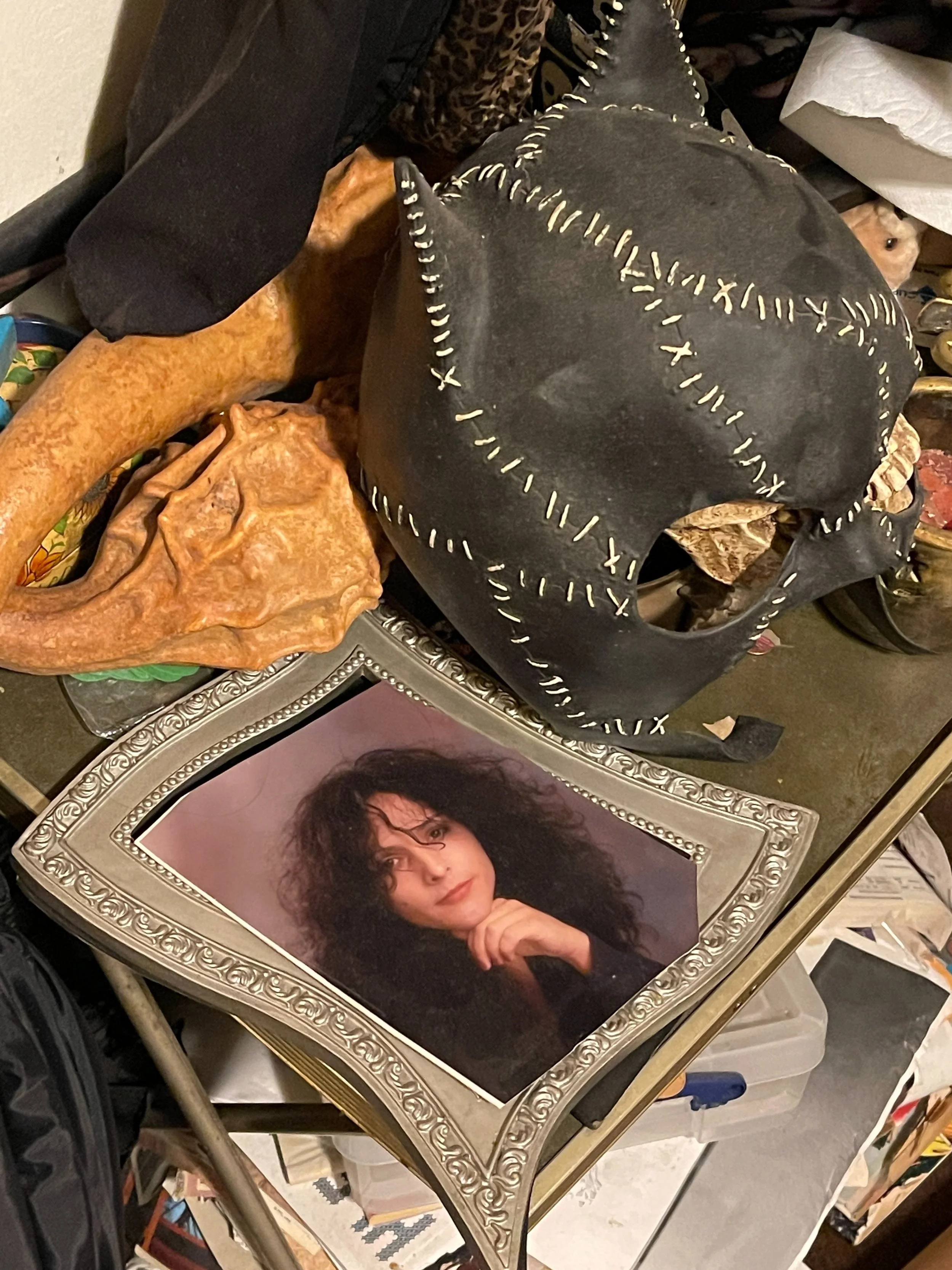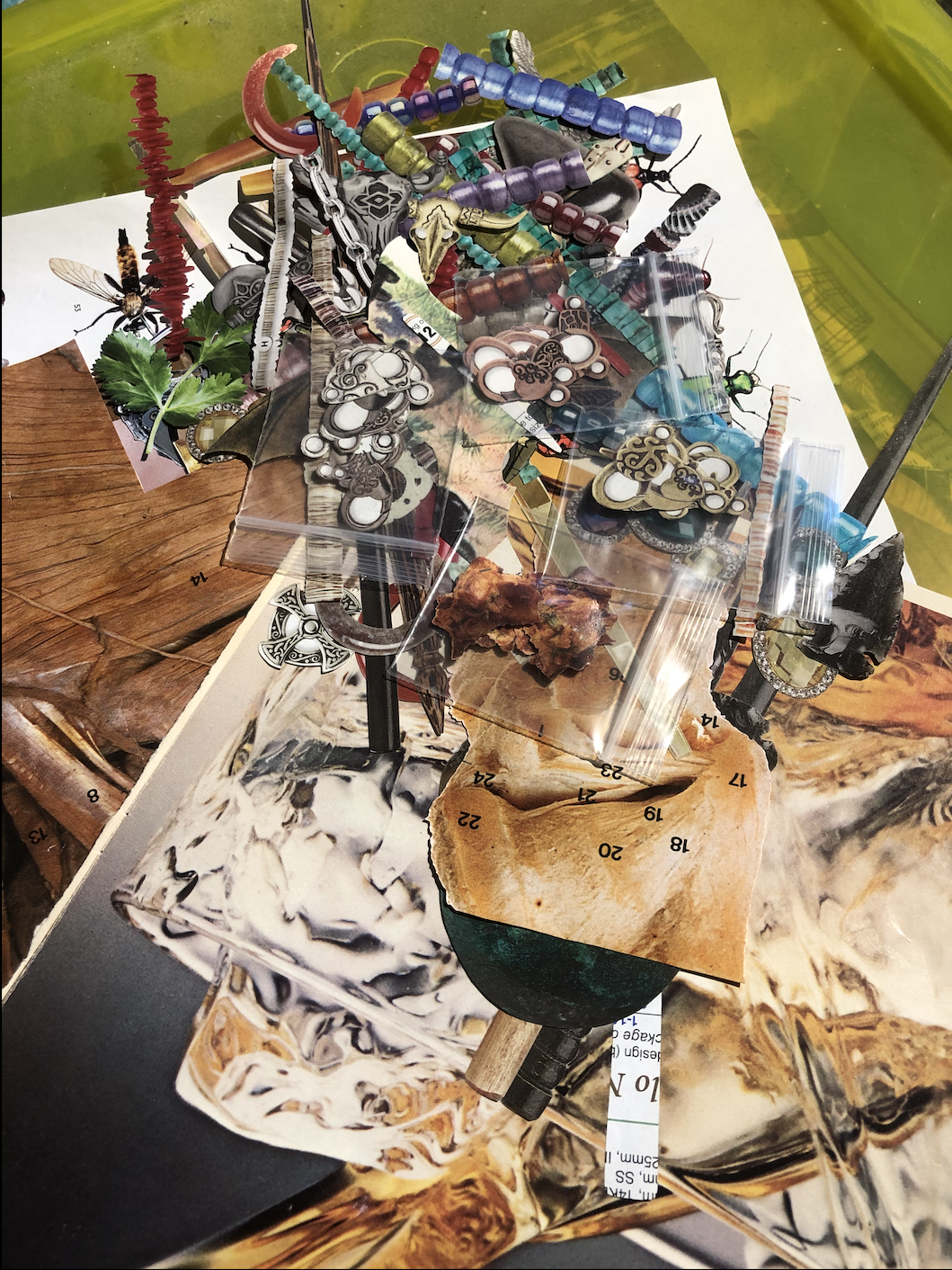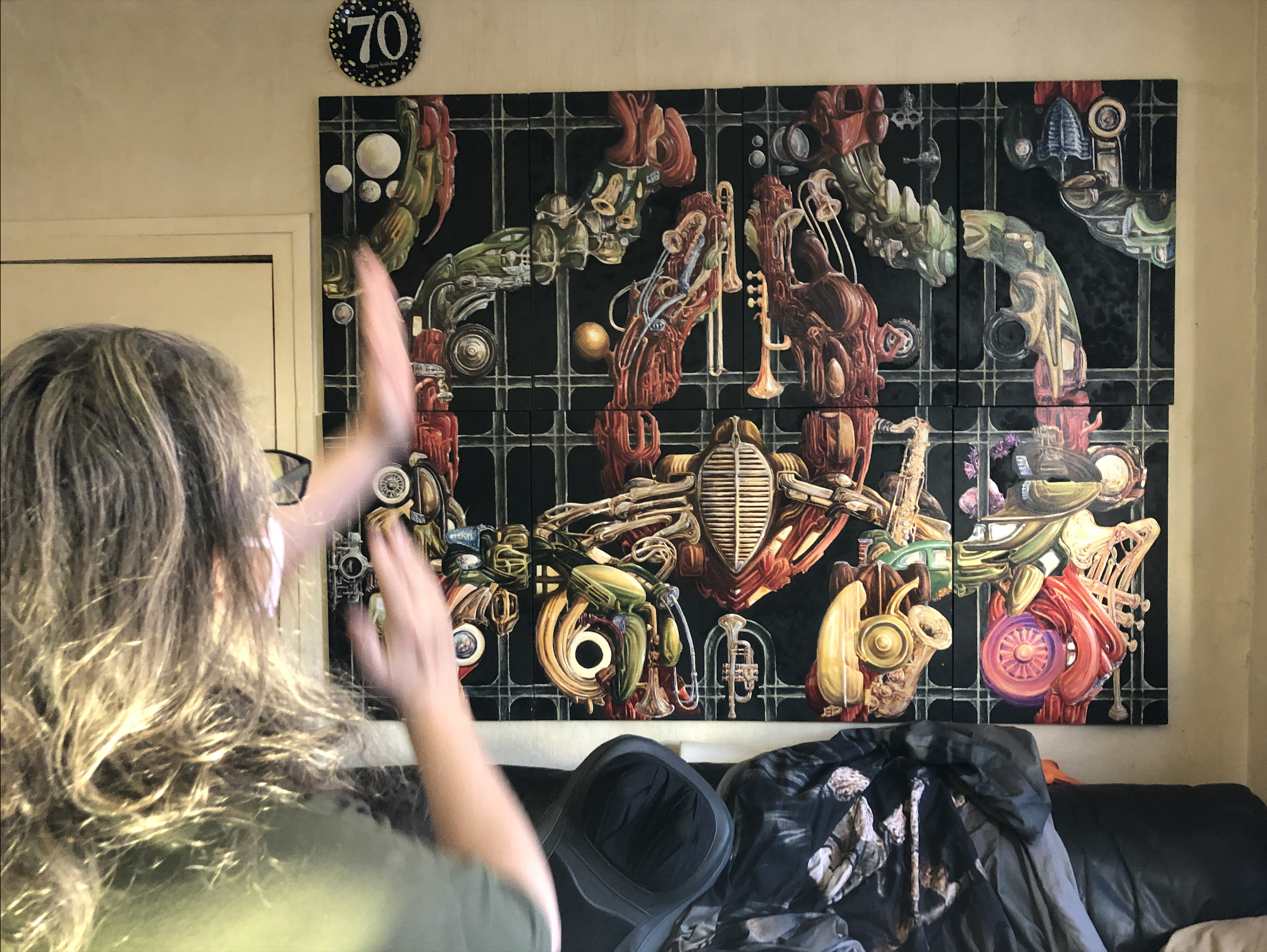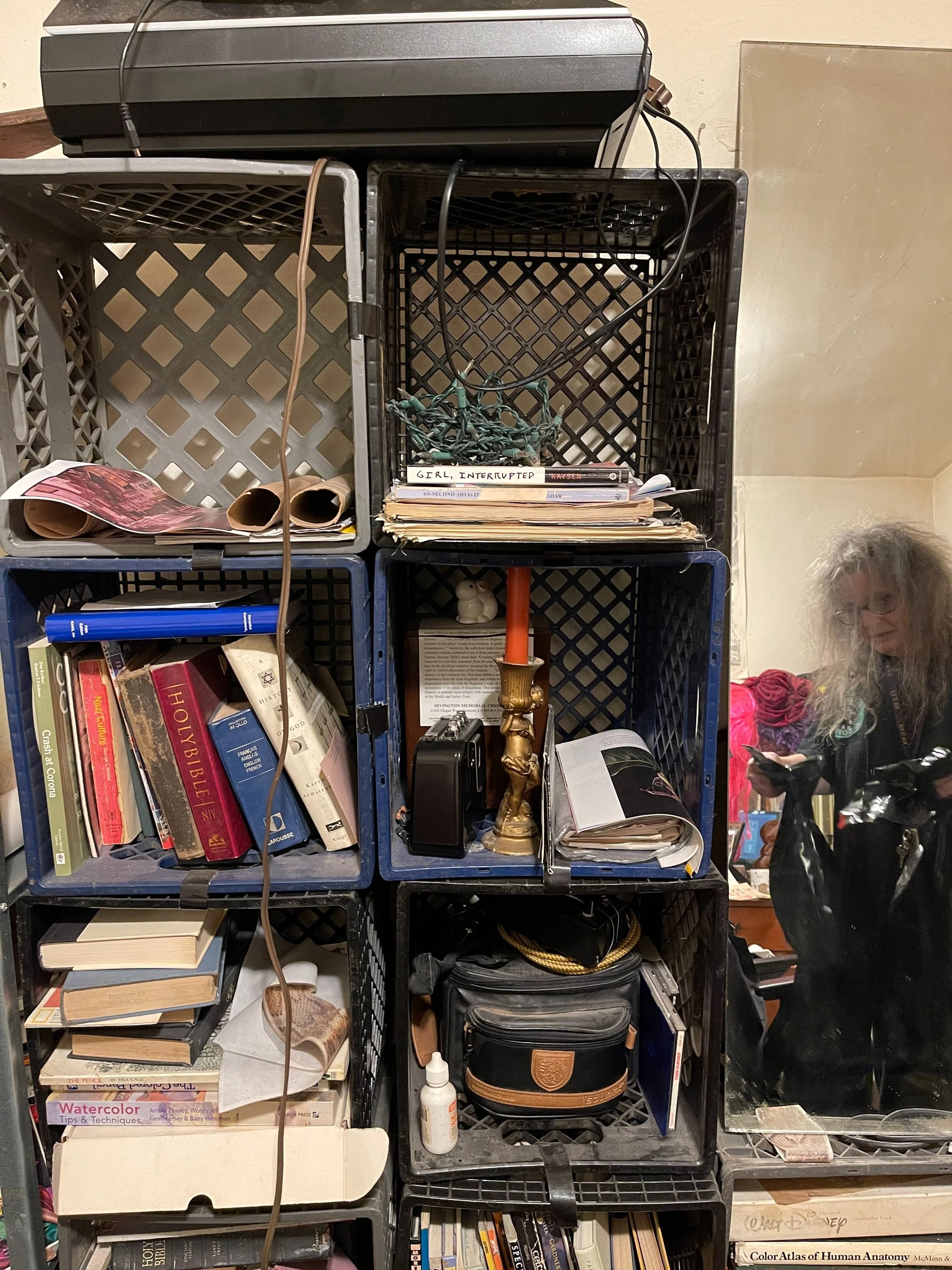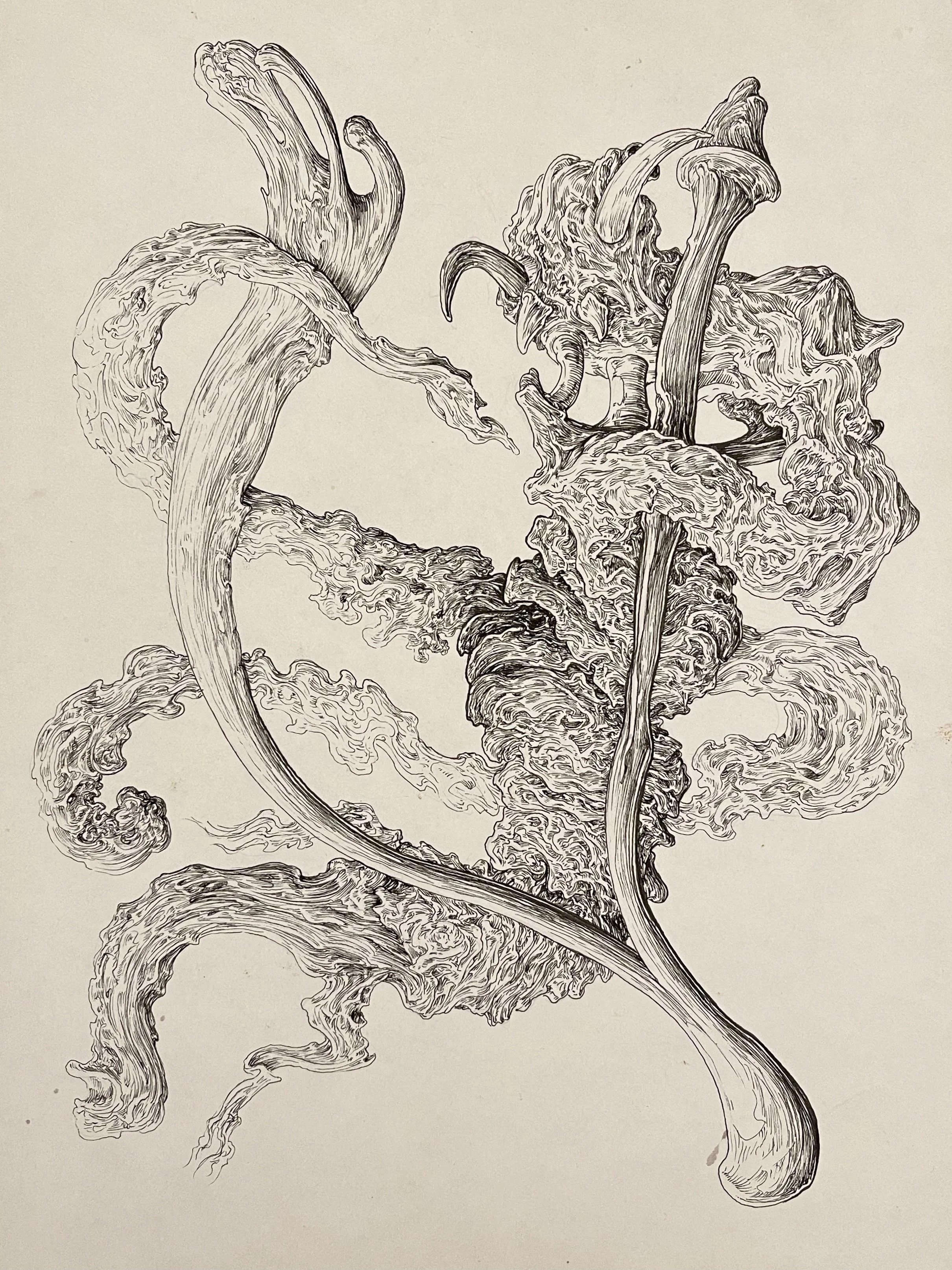Nola Vandella: The Best Kept Secret of the Tenderloin
By John Vochatzer
I met Nola Vandella officially about 5 years ago. Prior to that, I had just caught glimpses of her out and about and at local art exhibits in the neighborhood. With her frizzy gray hair, thigh high leather boots, and signature Starbucks “Guns & Coffee” t-shirt, she is quite hard to miss. In short, she looks like she fell asleep in a broom closet after speed balling backstage at a Motorhead concert in the 80s, and stumbled out into the Tenderloin 30 years later. Cobwebs and all.
What many might not suspect when looking upon Nola is the insanely multi-talented and prolific visual artist that lays beneath that wild, bedraggled visage. Apart from painting and illustration, Nola also works in collage and as of recently, video collage and animation. It was the collage that first got us talking to each other outside of an exhibit at The Loin Gallery (RIP) one afternoon. Nola had recognized my work from the neighborhood, and somehow or another this led into a challenge between us to see who had the biggest collection of paper collage cut-outs hoarded over the years. From there I discovered that she was my next door neighbor and lived in the big brick section 8 building adjacent to the apartment building I was living in at the time, and our friendship has been budding ever since.
This article itself is a few years at least in the making. Aside from being able to talk at length for hours about her art and her views on art, Nola’s history as a trans-woman living in the Tenderloin for several decades itself wields some incredible stories. I had originally intended to publish a more traditional question-and-answer interview with her, but after several gruntled refusals to respond to anything written, the recorded interview I attempted was answered with a run-on splurge of half sentences, hand gestures, and onomatopoeias that were barely transcribable, let alone readable. So finally I’ve resolved to just try to wrangle all of these notes and conversations I’ve collected over the past couple years into something a little more bio/editorial style. Sorry in advance Nola!
Nola was born in Hollywood in 1952. She spent most of her early childhood in the Canova Park area while her mom worked in the movie industry under the likes of Edith Head and other big names at the time. At the age of 5, amidst the heightened paranoia of McCarthyism, Nola migrated up to the Bay Area with her mother and step father. She spent the rest of her youth shuffling from place to place, living in areas like Palo Alto and other parts of the South Bay and the peninsula. After reaching adulthood she immediately moved to San Francisco, eventually landing in the Tenderloin somewhere in the mid 80’s which she has called home since.
A third generation artist herself, Nola reflects on memories of her grandfather who was a professional painter and illustrator. Specializing in portraiture of children, her mother had frequently been used as a model and there were always paintings upon paintings of her throughout the house. “If you couldn’t afford a Rockwell, you could get a Kelley,” Nola remembers as being a saying at the time. In turn, her grandfather passed down some of his expertise to his daughter who he recognized as naturally gifted, who in turn did the same to Nola. But by the time Nola reached junior high however, and amidst the rebellion of the 1960s, she says her mom began to seriously second guess her decision to do so. “Oh, no no no no. Why did I teach you to draw so well? Don’t be an artist,” Nola impersonates. “You want to be an architect. You’ll have a lot of money. You can buy a home. You can have kids and paint on the weekends. But oh, don’t be an artist. You’ll end up in the gutter. A drug addict.”
Her belated attempts to dissuade Nola didn’t work, and by high school the seed was already sown. Already exceptionally talented at rendering by this time, Nola’s training as an artist after that was for the most part auto-didactic. Aside from sneaking into an occasional class at SFAI or the Academy of Art, and taking a painting course at the city college, a large majority of her training and progress as an adult came from the swarm of counter culture art that had begun to become mass produced and easily accessible in the late 1960s and 70s. Her influences at the time ranged from psychedelic album art to Dalí, HR Giger, and the architecture of Antoni Gaudí who she often talks passionately and at length about.
In the mid 1980s, Nola moved to the Tenderloin, into an area historically known for its transgender population. Some of the stories she has that ensue from here on out for the next two decades range from charmingly quirky to downright insane. The Tenderloin then was a seedy place of “prostitutes, drug dealers, burglars, and alcoholics.” It still is, but back then it was just somewhere that the average person didn’t go or would get eaten alive. “You had all your different breeds; your meth heads, you had your heroin addicts. People did psychedelics and PCP. There were lots of dingy bars that were full of either people out on parole, people that were going to be out on parole, or people that hung out with people out on parole.” Nola reminisces.
According to Nola, back then you didn’t have “homeless,” you had “bums.” She has plenty of memories herself of sneaking in behind people at 3:00 in the morning and passing out in the hallways of apartment buildings. Or taking the bus to raid the coed dormitories at Stanford for eggs and bacon and a place to rest. Though out of all of her personal tales of drugs and mayhem and bumming around the TL breaking into cars and buildings, my personal favorite is the story about the time her friend Christine tried to seduce her after she had chopped off four of her own fingers with a homemade machete during a PCP flashback. The story only gets wilder from there but we’ll leave it at that for now.
When asked, however, how her trans identity and several years living in the Tenderloin has affected her creative output, her only response is: “not one fucking bit.” For Nola, there is no correlation between any of her identity politics and her artistic visions and pursuits. “I could draw the same shit in Beverly Hills, The Tenderloin, Palo Alto, Santa Rosa, Oakland. It doesn’t matter where I live.” She states. Nola goes so far as to even scoff at the idea of doing “trans art,” making the comparison “Oh, you’re half Italian. Do you do half Italian artwork?”
A framed portrait of Selena lays flat on top of a dresser beside a Catwoman mask
The mid-1990s ushered in a whole new era of inspiration for Nola. The most momentous occurrence during this period was when Nola met the love of her life, Selena, who she remained with until Selena’s passing a few years back. Selena, a guitarist, was the musical counterpart to Nola the artist, and together over the next couple decades the two of them drew endless inspiration from each other. The way Nola describes it, their meeting was love at first sight. Selena was in a band “Lipstick Addiction” at the time, and recognizing her after being introduced by a friend, Nola (in a starstruck haze) said “you’re coming home with me.” She didn’t let her out of her sight for 22 years after that.
The 90s and early 2000s also saw the emergence of a whole new wave of lowbrow, surrealist, and psychedelic art becoming more and more popularized and widespread thanks to the likes of Robert Williams, Juxtapoz Magazine, and others. Some of the art coming out during these times opened up entirely new worlds of possibilities to Nola and she still remains mind-blown by the caliber of work consistently being produced by these younger generations of emerging artists. One particular favorite of Nola’s has always been Greg “Craola” Simkins, who’s work she has taped up all around her apartment and she traveled down to LA a few years ago to view one of his exhibits. Contrary to this post-modern gospel that “everything has been done,” Nola and I have both always agreed that we feel as if we’re living in a sort of mini-renaissance of new styles and ideas. “Nowadays it’s off the charts. I can’t even keep up with how many unique artists there are,” she says. “You can spend an hour just trying to describe their styles.”
Another artistic inclination that Nola and I personally connect on (and apart from us both being incorrigible maximalists) is on the gravitation between pen-and-ink illustration and collage art as our two preferred mediums. I’ve always considered these two mediums to require almost entirely opposite modes of thought, and in our conversations Nola brought to my attention that one can be looked at as additive, and the other as subtractive, at least in her approach. “With drawing, you start with a blank page. You either render what's in front of you, or you render the idea you have in your head. But you start from zero,” Nola explains. “Now collage starts with lots and lots of pieces. And I combine and reconfigure them into something I start to like here and there. You start with lots of images and the process turns them into one thing; usually something other than what they started as.”
While distinguishing these “opposite directions” as the primary difference for her between the process of illustrating and collage making, Nola says that the stylistic differences therein are a whole other can of worms.
Nola’s catalog of illustration work consists of binders upon binders of meticulously detailed drawings, many of which are on cheap copy paper or the backs of junk mail or clerical documents, and stained with the occasional rib grease or Ancient Age Whiskey & Coca Cola spillage. Canvas choices aside, the drawings themselves are each elegant and musical masterpieces unto themselves; phallic and yonic organic free-for-alls, oftentimes pierced or intersected by a solitary shape or fragment of modern machinery. The near disregard for any standard of archival preservation almost adds to the beauty of these swirling, phantasmagoric contortions of the imagination.
Her collage work on the other hand, while of an equally playful and visionary caliber, is much more disorganized and some might even consider underdeveloped by comparison. While sorting through the piles and piles of cut-outs in her apartment, one recurring theme I noticed was there tended to be a lot of imagery of food. When I asked what it was about food that made her like to incorporate it into the re-contextualization process of collage art, she responded: “Sometimes I’ll re-contextualize, sure, but mostly I can just stare at pictures of food. You know how much work they go through to get that fried chicken to look really sizzling like that? It’s a fine art. Whoa.”
Ogling aside, Nola’s fixation on edible items as artistic motifs actually dates far back to her childhood, and particularly to one of her favorite remembered past times: playing with her food. “Any 4-year-old will tell you that’s not parsley. That’s a tree. You put it in your mashed potatoes. Put some more in there. You have a little forest,” Nola reflects. “I still do that. I’ll do it in restaurants.” As jesting as this sounds, it adequately falls into what I’d summarize as Nola’s main ambition as an artist, and which she describes as “doing the impossible.” Even before being introduced to Surrealism, Nola recalls visualizing things such as a truck driving across her plate of pancakes as a child, or a building erected next to her glass of milk, and teaching herself to work out all of the perspective obstacles in her head before rendering such visions to paper. “If you can hold it in your head and it looks the same for ten minutes, solid, with no changes. Then it’s time to get out the pencil.”
Nola’s most recent creative endeavor over the past few years has been digitally scanning all of her collage cut-outs collected throughout her life and arranging them into fascinating and mesmerizing animations. This has been an ambition of Nola’s for a long time now, and I remember her having talked about it since we first met. Finally with the help of her friend Christine (Yes, the six fingered machete wielder) she has been gradually learning Photoshop and other digital animation software to bring these visions into reality. When asked about the process, Nola refers to it as equal parts “maddening frustration and aggravation” and “giddy, childlike excitement.” She says the learning curve is real slow, but from what I’ve personally seen so far she has quite a knack for it, and especially for someone of a generation commonly more detached from such technology.
Nola will be having her first ever solo exhibit with us at Moth Belly Gallery next week. Falling on January 6th, the exhibit is appropriately titled “Visual Insurrection” and will showcase dozens of her pen drawings, her paintings, and even samples of her video collage work. To Nola, to be a modern artist it’s best to be a revolutionary at heart. “In school, I was always in trouble,” Nola says. “I never understood how none of the other kids were in all this trouble. I don’t know, I just felt like doing it all. The same stance of being on the wrong side of authority is why I mix things that don’t go together. You know, is that a saxophone or a loaf of bread? I think it’s both. That’s insurrection because it’s supposed to be one or the other.”
Visual Insurrection will run for the entirety of January, 2022, and is dedicated to her partner Selena.

